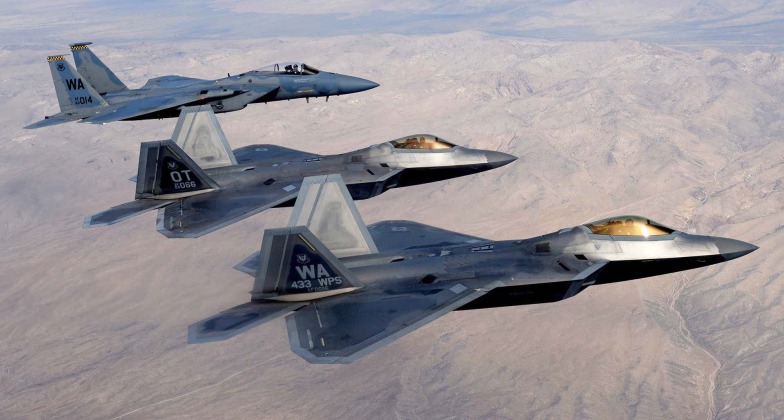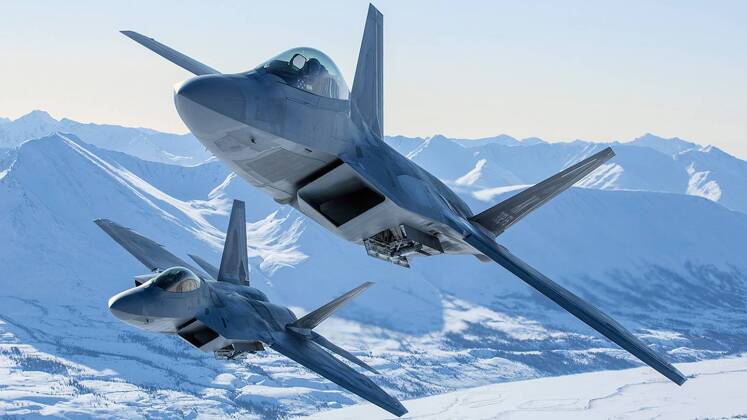News
25 Years Since the F-22’s Maiden Flight: America’s First Fifth Gen. Fighter Increasingly Looks Like a Failure
September 7 2022 marks 25 years since the first flight of the world’s first fifth generation fighter the F-22A Raptor, with the aircraft designed as a twin engine heavyweight platform to succeed the F-15 Eagle and F-4D/E Phantom as the Western world’s prime air superiority fighter. Developed under the Advanced Tactical Fighter Program which began work in the late 1970s, the F-22 design proposed by Lockheed Martin was chosen over the rival F-23 developed by Northrop Grumman, and was considered the more conservative of the two deviating less radically from the F-15. The end of the Cold War in 1989, however, and subsequent collapse of Soviet fifth generation fighter programs after the state’s disintegration in the 1990s meant Advanced Tactical Fighter was not expected to have a near peer competitor, which was considered a major factor why the more ambitious but likely much riskier and more costly Northrop proposal was not selected.
Had the USSR not disintegrated, the MiG 1.42 program was expected to see its first technology demonstrator fly in 1993-94, three to four years after its American rivals the YF-23 and YF-22, with the aircraft boasting sensors and an engine significantly surpassing the power of their U.S. counterparts. Without the USSR, however, it would be decades before Russia would field a fifth generation fighter – with the country having yet to form a full sized fifth generation squadron placing it two decades behind where the Soviet Air Force was expected to be. While the Soviet Union’s top fourth generation fighter the Su-27 was evaluated in the U.S. to have comfortably surpassed the performance of its American rival the F-15, and was being produced on a comparable scale, Russia’s much poorer economy and tech sector after 1991 ensured that this feat would not be replicated in the fifth generation.

Although the end of the Cold War and Soviet collapse were highly beneficial in placing the F-22 effectively in a league of its own, the sharp contraction of American industry that decade and reductions to defence spending undermined the program leading to very significant delays. This included the tremendous seven year gap between the first flight of the YF-22 demonstrator and the first pre-production F-22, and a further delays of over eight years before the fighter gained an initial operating capability in the U.S. Air Force in December 2005. Upon entering service the fighter was quickly recognised as problematic, with issues such as the ‘Raptor cough’ which took a signifiant toll on the health of its pilots, and the aircraft’s excessive maintenance requirements and resulting low readiness rates, all undermining its image.
Some of the most serious issues with the F-22 pertained to its avionics, with the fighter’s computer architecture being effectively obsolete by the time it entered service due to the very long delays to the program. 25 years after its first flight the F-22 still cannot share data with other fighter units, which is a tremendous handicap in the age of network centric warfare, and cannot fire any high off boresight weapons due to a lack of helmet mounted sights which leaves it effectively obsolete in visual range combat. The lack of features such as infrared search and track systems or distributed aperture systems, seen on newer fighters such as the lighter F-35 or the Raptor’s Chinese counterpart the J-20, further undermine the F-22’s ability to remain relevant on the modern battlefield.

The F-22’s performance issues, and most significantly its extreme operational costs and maintenance needs, made pursuing even half the production run originally envisioned unviable, with production cut by 75 percent to just 187 airframes. These cuts and the lack of economies of scale from larger production contributed to raising costs, which per airframe increased from $149 million to a staggering $412 million. Orders to terminate production were given less than four years after the F-22 entered service, which reflected the seriousness of problems with the program. To place this in perspective, the F-15 is expected to remain in production for over half a century after entering service, while the F-4 continued to be produced for 20 years after its service entry.
Although there were frequent calls made to extend or restart F-22 production, it became increasingly apparent that the Air Force did not see a larger Raptor fleet as beneficial – with their performance issues and tremendous operational costs making them among the least cost effective combat assets in the fleet. This was perhaps best demonstrated by the Air Force’s decision to begin retiring F-22s in 2023, while continuing to buy more F-15s, despite the Raptors having expended only a very small fraction of their service lives. This demonstrated that even with F-22s already paid for and having years left to fly, it was preferable to retire them and pay more to build new F-15s – the very aircraft they was meant to replace.
The F-22 program achieved some important milestones, including being the first stealth fighter built for air to air combat, providing a technological stepping stone for development of the F-35, and being the only Western fighter to integrate thrust vectoring engines for manoeuvrability. The program nevertheless appears very far from successful a quarter century on particularly compared to its Cold War era predecessors and to many of its overseas competitors, which has become increasingly apparent as plans to retire the aircraft begin to materialise which confirm what was long speculated when orders to cut production were first given. The fighter is expected to see only a fraction of the time in service that the F-15 will, with the Air Force confirming in 2021 plans to retire the class completely in the 2030s.












